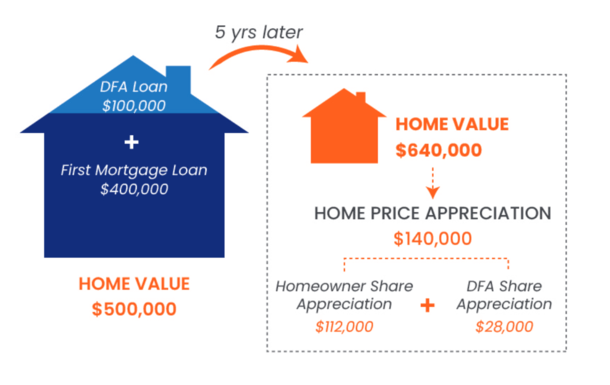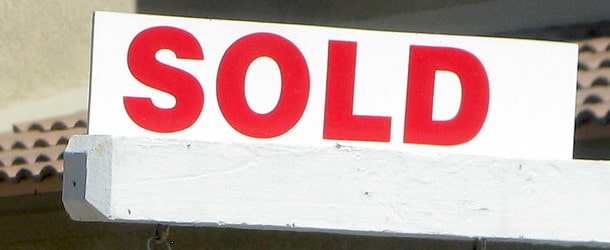The California Housing Finance Agency has launched a new shared appreciation loan for home buyers.
The program, known as the “Dream For All Shared Appreciation Loan,” allows Californians to build wealth via homeownership without a down payment.
In lieu of that down payment, they must share a portion of their home’s future appreciation.
While that can be a costly tradeoff, it does eliminate the need for a significant amount of money at closing.
And by avoiding a larger loan amount or second mortgage, a home purchase can remain affordable.
How the Dream For All Shared Appreciation Loan Works
In a nutshell, home buyers in the state of California can get their hands on a zero down mortgage, but they must trade a portion of future home price appreciation.
So if a prospective buyer doesn’t have a 20% down payment (or even a 5% down payment), they can take out a shared appreciation loan instead.
For example, if the purchase price were $500,000 they could obtain a $400,000 first mortgage at 80% loan-to-value (LTV).
Then CalHFA would provide a $100,000 DFA (Dream For All) loan that doesn’t require monthly payments.
Instead, the shared appreciation loan is paid back only when the property is sold or transferred, or the mortgage refinanced.
As a result, the homeowner would have a smaller loan amount ($400,000) and the borrower would avoid costly private mortgage insurance.
Shared Appreciation Loan vs. 3% Down Payment
| $500,000 Home Purchase | 3% Down Payment | 20% Down w/ DFA Loan |
| Loan Amount | $485,000 | $400,000 |
| Mortgage Rate | 6.5% | 6% |
| Monthly P&I | $3,065.53 | $2,398.20 |
| Mortgage Insurance | $226 | N/A |
| Total | $3,291.53 | $2,398.20 |
While other solutions exist that require just a 3% down payment, monthly costs can still be much higher.
This is driven by both a higher loan amount at 97% LTV, along with compulsory mortgage insurance for LTVs above 80%.
Together, borrowers face higher housing expenses each month, potentially putting homeownership out of reach.
The table above is an example I came up with on a hypothetical $500,000 home purchase.
As you can see, the 3% down payment results in a monthly mortgage payment of $3,291.53.
Meanwhile, the 20% down mortgage combined with a shared appreciation loan results in a monthly payment of just $2,398.20.
This is thanks to a higher mortgage rate at 97% LTV, a larger loan amount, and monthly private mortgage insurance (PMI).
That could make the home purchase unaffordable for a low- or moderate-income home buyer.
*The effective interest rate on the DFA is equal to the average annual appreciation of the home during the time it is held.
How Much Future Appreciation Is Shared?

As noted, the home buyer doesn’t have to make payments on the shared appreciation loan.
But upon sale, transfer, or refinance, they must pay off the loan and part with a percentage of appreciation.
Borrowers with incomes above 80% Area Median Income (AMI) are subject to a 1:1 appreciation share.
For example, if you borrow 20% via the shared appreciation loan and the home price increased $140,000, 20% of that total ($28,000) would go back to CalHFA.
Borrower with incomes of less than or equal to 80% AMI get a reduced 0.75:1 appreciation share.
So those borrowing 20% would only share 15% of future price appreciation, or $21,000 in their example.
Dream For All Shared Appreciation Loan Requirements
- Must be a first-time home buyer and complete education
- Property must be one-unit owner-occupied house or condo
- Income limits up to 150% AMI based on CalHFA’s income limits
- Must be paired with a Dream For All conventional first mortgage
- Minimum CLTV is 70%
- Maximum CLTV is 105%
- Shared appreciation loan amount up to 20% of sales price or appraised value
To qualify for the Dream For All Shared Appreciation Loan, borrowers need to be first-time home buyers.
This generally means someone who has not owned and occupied their own property in the past three years.
Additionally, two levels of homebuyer education counseling must be completed and the borrower must obtain a certificate of completion through an eligible counseling organization.
The property must be a single-family residence (1-unit only) or an approved condominium/PUD. Manufactured housing is also permitted.
And it must be owner-occupied (no second homes or investment properties) and non-occupant co-borrowers are not permitted.
Lastly, it must be used in conjunction with the Dream For All conventional first mortgage.
Are Shared Appreciation Loans Bad for the Housing Market?
While shared appreciation loans can boost affordability, they may have the unintended consequence of inflating home prices.
If buyers can’t actually qualify for a mortgage without massive help, it might mean there’s a market imbalance.
Absent accommodating programs like these, asking prices might be forced lower to better align area incomes with area home prices.
But we’ll never know if creative financing like this continues to surface, thereby keeping demand in place no matter the price.
The goal of this particular program is to increase wealth for those with low- and median-incomes, as home equity is a major driver of wealth.
However, what happens if home prices don’t appreciate like the example illustrates?
Perhaps buying a cheaper home and realizing the full amount of appreciation is a better way forward.
Regardless, with home prices still far outpacing incomes, programs like these will continue to persist.
Read more: Unison Will Provide Half Your Down Payment in Exchange for Future Appreciation


